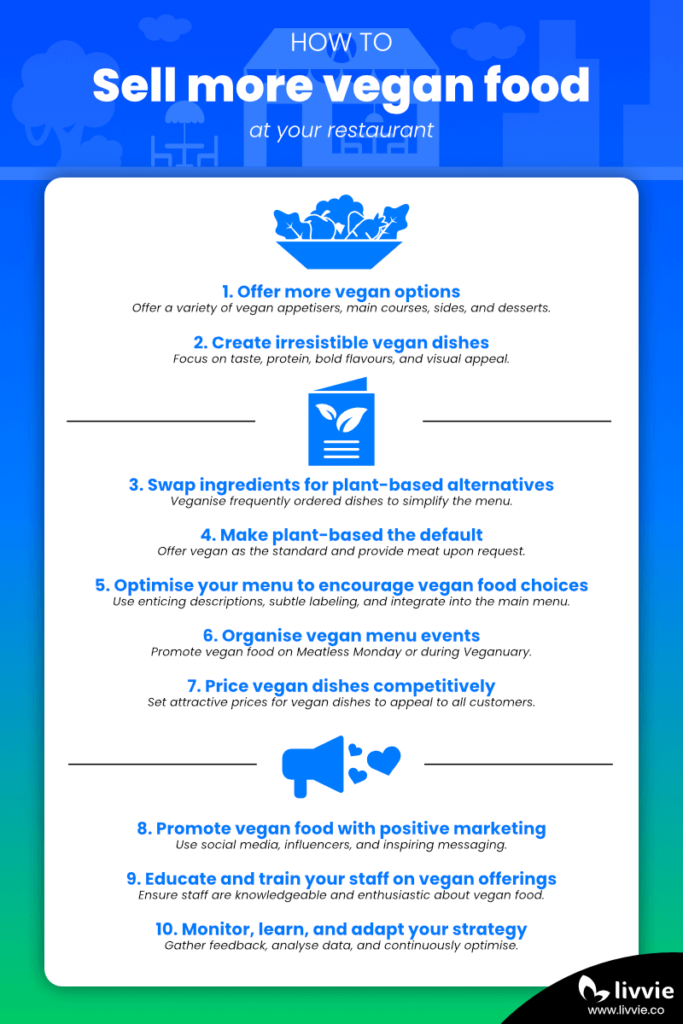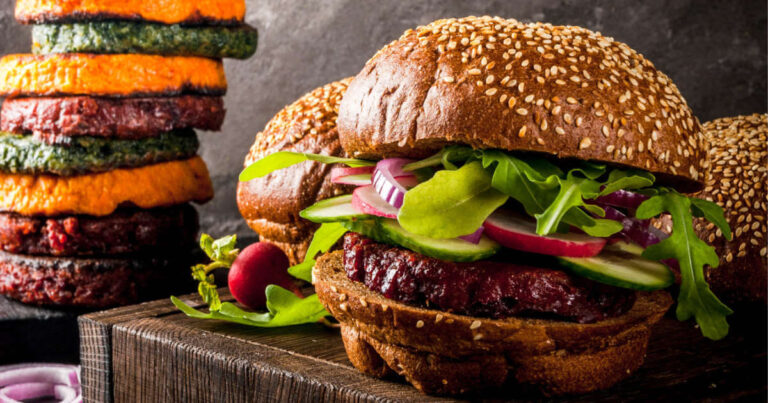Marketing Strategies to Sell More Vegan Food at Restaurants
Written by Johanna van Langen
Published 5 July 2024
As consumer preferences shift towards healthier and sustainable choices, offering vegan dishes presents a great opportunity to drive your restaurant’s success. By promoting vegan options, you can attract new customers, enhance your brand image, and support your Environmental, Social, and Governance (ESG) goals.
This guide outlines effective marketing strategies to help you promote and sell more vegan food at your restaurant. Read on to discover how simple plant-based ingredient replacements and menu optimisations that influence customer preferences can boost your vegan food sales.

Easily calculate the positive impact of your vegan food sales
The Benefits of Promoting Vegan Dishes
Promoting vegan dishes at your restaurant is a strategic move that supports your business and ESG goals. Marketing vegan menu options expands your audience as more people adopt vegan, vegetarian, and flexitarian diets.
Consumers choose plant-based food for various reasons, including health benefits, ethics, sustainability, and cultural background. Offering a range of vegan options caters to diverse groups and shows your commitment to inclusivity. Highlighting your vegan dishes positions your restaurant as a forward-thinking culinary innovator.
Animal agriculture causes environmental issues such as deforestation, water pollution, and climate change. Promoting vegan food and its benefits advances the transition towards a more sustainable plant-based food system. Selling more vegan food lowers your environmental footprint, which resonates with customers who care about sustainability.
Many people avoid meat and dairy for health reasons, including allergies and food intolerances. Providing healthy vegan dishes attracts health-conscious customers and shows you care about their well-being. Vegan ingredients often have lower costs, allowing you to offer affordable meals with healthy margins.
By promoting and selling more vegan dishes, you enhance your restaurant’s brand image, attract new customers, and drive sustainability.
Now that you understand why, continue reading to learn how you can increase vegan food sales.

Effective Strategies to Sell More Vegan Food
1. Expand Your Vegan Menu Options
2. Create Irresistible Vegan Dishes
3. Swap Animal Ingredients for Plant-Based Alternatives
4. Make Plant-Based the Default Choice
5. Optimise Your Menu to Encourage Vegan Food Choices
7. Price Vegan Dishes Competitively
8. Promote Vegan Food With Positive Marketing
1. Expand Your Vegan Menu Options
The most straightforward way to sell more vegan food is by offering more options on your menu.
Finding a restaurant with vegan options can be challenging. By providing a variety of vegan appetisers, main courses, sides, and desserts, you make your restaurant more welcoming to vegans. This can attract new customers and increase group bookings, boosting the sales of your plant-based dishes.
While a vegan diet has restrictions, meat-eaters don’t always need to eat meat. Omnivores are a growing segment and many already consume meat and dairy replacements regularly. In Europe, 27% of people have adopted a flexitarian diet and prefer to eat vegetarian or plant-based without entirely excluding animal products. A plant-forward menu particularly appeals to flexitarians, making it easier for them to choose dishes that fit their lifestyle.
Increasing the number of vegetarian and vegan options can shift perceptions about plant-based food. By making plant-based dishes a substantial part of your menu, you normalise these options and encourage customers to choose them. That is how simply adding more options to your menu can significantly increase sales of vegan food.
When expanding your menu with vegan items, apply the following best practices to encourage customers to choose them.
2. Create Irresistible Vegan Dishes
To sell more vegan food, it’s essential to tempt customers with appetising vegan dishes. The following tips help to make your vegan menu items irresistible.
Prioritise taste
Taste is the primary motivational driver for food choices. By focusing on flavour, you can attract flexitarians and omnivores to your vegan offerings. Make sure your vegan dishes are both satisfying and satiating, not mere salads or vegetables.
Protein first
Think about protein first when creating vegan dishes, as you would with meat dishes. Use meat alternatives or cook with raw ingredients like beans, legumes, tofu, tempeh, or seitan. Enrich dishes with protein-rich nuts and seeds to add texture and nutrition.
Use bold flavours
Use bold flavours to make your vegan dishes exciting. International cuisines that rely less on animal products offer a wealth of inspiration for spices and seasonings. Experiment with different flavour profiles to make your vegan dishes stand out.
Focus on visual appeal
Presentation matters. Plate your vegan dishes in an attractive way to impress your customers and create beautiful pictures for your menu and social media to generate interest.
Leverage familiarity
Familiar meals and flavours resonate best with customers. You could offer plant-based versions of popular dishes like spaghetti with meatballs, burgers, or lasagne. Familiarity helps set the right expectations and makes vegan options more approachable.
Add your unique twist
While familiarity is important, don’t shy away from adding your own twist or introducing a few innovative dishes. Highlighting that a familiar dish is made from plants can itself be a novelty.
Align with your brand
Ensure your vegan dishes represent your brand and align with the rest of your menu. Keep checking in with your customers to gather feedback and understand their needs.
By following these guidelines, you can create vegan dishes that appeal to vegans, flexitarians, and omnivores, driving up vegan food sales.

3. Swap Animal Ingredients for Plant-Based Alternatives
An easy way to serve more vegan food is to replace animal ingredients with plant-based alternatives.
Swapping ingredients to veganise dishes can be a quick win to sell more vegan food. For instance, offer guests the possibility to request a vegan patty for their burger. Make sure the other components of the dish are already vegan to streamline kitchen operations.
Transitioning to plant-based alternatives can simplify your menu and reduce custom requests. Frequently ordered side dishes like bread, mayonnaise, and other sauces are ideal to veganise. Using oil or vegan dairy alternatives can maintain the taste while making the dish accessible to all customers. Vegan dishes accommodate most guests with dietary restrictions, easing the workload for your waiting and kitchen staff.
Another strategy is to reduce portions of meat or fish in existing dishes while enriching them with plant protein sources. This appeals to flexitarians and helps in managing food costs.
With simple ingredient swaps, you create an inclusive menu that can increase vegan food sales and improve operational efficiency.
4. Make Plant-Based the Default Choice
Making plant-based dishes the default option on your menu is a powerful way to increase vegan food sales.
When offering both animal-based and vegan versions of a dish, make the vegan version the default. This simple change is an effective strategy to increase the number of vegan meals served, as customers are less likely to request a change. By making plant-based the default, you create the perception that vegan options are the standard. This encourages customers to choose them because they don’t like to deviate from the norm. This subtle nudge can significantly boost your vegan food sales without compromising customer choice.
Another quick win is to make plant-based milk the standard for coffee orders. Offer popular options like oat milk, soy milk, or almond milk as the default choice.
Consider always offering a plant-based dish as the day special to draw attention to it and encourage customers to order it.
By making plant-based dishes the default, you influence customers to order vegan food more often, contributing to your sustainability goals.

5. Optimise Your Menu to Encourage Vegan Food Choices
If you want to encourage customers to choose vegan dishes, you can optimise the menu with the following strategies.
Emphasise taste in descriptions
Language plays a vital role in driving food choices. Use enticing descriptions that highlight flavours, textures and preparation methods to inspire selection of a dish. Words like “smoky”, “crispy”, “creamy”, or “roasted” can make food sound more appetising and sets the right expectations.
Highlight familiarity and tradition
People are attracted to familiar meals and traditional flavours. Reference classic favourites, popular cuisines, or appeal to nostalgia by using words like “classic”, “Caribbean”, or “home-style”.
Use positive language
Highlight the positive properties of the dish and avoid using negative or restrictive wording. It is better to use “high protein” rather than “low fat” or “meat-free”. The words “vegan” and “vegetarian” are perceived as exclusive, and it is better to use “plant-based” or “plant protein”.
Promote the benefits of vegan dishes
Emphasise the benefits of a plant-based dish for their health, the planet, or animals to encourage customers to order it. You can use statements like “eco-friendly” or data about the social impact of a dish or your restaurant’s vegan menu strategy. This affirms your business values and attracts customers who care about their health and the environment.
Label vegan dishes subtly
Clearly mark vegetarian and vegan dishes to accommodate people with dietary restrictions. This helps customers during their search for a restaurant and prevents questions to your waiters. Use labels subtly by using a small “v”, “vg”, or icon, and explain their meaning.
Integrate vegan dishes in the menu
Integrate vegan options into the main menu instead of a separate section. This ensures they are perceived as delicious as other options and accessible to all diners. Keep in mind you want to draw meat-eaters towards your vegan dishes to sell more of them. Place them strategically at the top or bottom of the menu to increase visibility or highlight them as “recommended” or “popular”.
By optimising your menu with these strategies, you make your vegan dishes more appealing to boost vegan food sales at your restaurant.

6. Organise Vegan Menu Events
Organising vegan menu events is a great way to boost your vegan food sales and attract new customers.
Choose one day of the week to promote your vegan dishes or offer a special vegan menu. You can leverage well-known vegan initiatives like Meatless Monday or Veganuary. Expand your vegan options and promotions on Monday or consider a vegan menu initiative in January.
For these events, you can create exclusive vegan day specials, offer extra options, or create a menu where all dishes plant-based by default. This draws attention to your vegan offerings and encourages repeat visits from customers looking for these options.
If feasible, experiment with a temporary vegan menu or pop-up restaurant. Larger chains can follow the example of Burger King, which has successfully opened plant-based pop-up restaurants across several countries. This can increase your brand’s visibility and attract a new customer base.
Special vegan events are a perfect opportunity to create an engaging marketing campaign. Use social media, email newsletters, and in-restaurant signage to inform your customers about upcoming events.
By organising vegan menu events, you can create media exposure for your restaurant, attract new customers, and increase vegan food sales.
7. Price Vegan Dishes Competitively
Pricing your vegan dishes competitively can make them more inviting to a broader audience and improve their sales.
Price is a foundational driver in all consumer buying decisions, including food. Price your vegan dishes lower than meat-based options to attract price-sensitive customers, especially omnivores and flexitarians. Competitive pricing can remove the barrier for those who want to try plant-based foods without spending more.
Raw plant-based ingredients are typically cheaper to purchase and store, so you can charge less while maintaining a healthy profit. But avoid pricing too low, as it may be associated with lower quality. Ensure price parity across your menu to maintain the sense of equal quality and value. Use descriptions that highlight the nutritional value and environmental benefits of your vegan dishes to elevate their perceived value.
With temporary promotions you can spotlight your vegan dishes and support marketing campaigns. Special offers during events like Meatless Monday or Veganuary may draw in new customers and encourage regulars to try plant-based.
When offering both vegan and meat versions of a dish, consider making the meat option available for a surcharge. This motivates customers to choose the vegan default and helps manage costs associated with animal-based ingredients.
By pricing your plant-based dishes competitively and accentuating their value they become more inviting to omnivores, increasing sales.
8. Promote Vegan Food With Positive Marketing
Effective marketing can substantially increase vegan food sales and enhance your restaurant’s brand image. You can promote your vegan offering across multiple touchpoints in your customer journey.
Grow Brand Awareness
Communicate the benefits of plant-based eating through targeted print and online messages to show that you care about health, sustainability, and animal welfare. Frame messages positively and rewarding by focusing on sustainable food choices as a solution. You can even calculate the positive impact of your restaurant’s vegan menu strategy to make your contributions to the planet and society tangible. Such values-based messages attract like-minded customers and influence attitudes towards your vegan menu items.
Partner with influencers who focus on veganism, health, or food. Influencers can help spread the word about your vegan offerings to a wider audience and give credibility to your brand.
Enhance Customer Loyalty
Within the restaurant, use walls, leaflets, or screens to present positive messages about plant-based food and feature popular vegan dishes. Ensure your waitstaff can confidently recommend vegan options to customers.
Encourage and reward customers for choosing vegan options. Offer loyalty programs, discounts, or coupons for plant-based orders. Positive reinforcement makes customers feel good about their choices and increases their likelihood of returning.
Invite guests to share their experience and highlight positive reviews and testimonials from customers who enjoyed your vegan dishes. Display these on your website, social media, and in-restaurant materials. Authentic customer feedback can build trust and influence new customers to try your vegan options.

9. Educate and Train Your Staff on Vegan Offerings
For above strategies to be successful, it’s important that your staff is knowledgeable and enthusiastic about your vegan menu. This requires education and training.
Ensure your waitstaff knows about different diets, allergies, and animal- or plant-based ingredients in your dishes. This enables them to confidently answer questions and recommend vegan options without needing to consult the kitchen.
Create enthusiasm by educating your staff on the benefits of vegan food for the restaurant and the planet. Explain how increasing vegan food sales aligns with your restaurant’s values and sustainability goals. Provide talking points to your staff about the taste, health benefits, and environmental impact of your vegan dishes. When employees are excited and informed, they can genuinely inspire customers to choose vegan dishes.
Offer trainings to teach kitchen staff about plant-based ingredients, flavours, and culinary techniques. This ensures that vegan dishes are as appetising and well-prepared as other menu items.
By investing in education and training, you empower your team to promote vegan menu items and increase their sales.

10. Monitor, Learn, and Optimise Your Strategy
To successfully sell more vegan food, it’s essential to continuously learn, monitor, and optimise your strategies.
Make sure you understand your target audience’s needs and preferences through market research. Find out what your customers expect from a vegan-friendly restaurant and what motivates their food choices. Gather feedback from guests about your vegan menu items and their experience through surveys, comment cards, or waitstaff.
Define specific targets and key performance indicators (KPIs) for increasing vegan food sales to measure success and identify areas for improvement. Analyse sales data to see which vegan dishes are performing well and which are not. Find patterns to understand what appeals to your customers and use this data to refine your menu and marketing strategies.
Be ready to adapt your strategies based on the feedback and data you collect and keep an eye on industry trends and vegan food innovations. Whether it’s tweaking menu items, adjusting pricing, or refining marketing messages, continuous improvement is key to success.
By monitoring and adapting, your vegan menu strategy stays responsive to customer needs, helping you sell more vegan food and build a loyal customer base.
Drive Restaurant Success With Vegan Food Sales
Selling more vegan food is a powerful way to support your restaurant’s business and ESG goals. By promoting vegan menu options, you can attract a broader audience, enhance your brand image, and contribute to environmental sustainability.
Implementing clever changes in menu descriptions and positioning can encourage customers to choose vegan dishes. Simple ingredient swaps to plant-based alternatives can also help you serve more vegan food effortlessly. Promoting vegan dishes offers a fantastic opportunity to emphasise your brand values in marketing messages and attract like-minded customers.
Start using the strategies in this guide to successfully market your vegan dishes, boost sales, and drive your restaurant’s business goals.
Use tangible data on the positive impact of your vegan menu strategy with the Livvie food impact calculator to support your marketing efforts.

Share this article to inspire your colleagues and take the first step towards a more sustainable and profitable future for your restaurant.

